The Pound-to-Dollar Week Ahead: Charts Point Below 1.20 as Epidemic Curve Threatens Sterling
- Written by: James Skinner
- GBP/USD suffers its worst weekly loss Brexit referendum at -5.9%.
- Volatility ahead with downside to at least 1.1980, upside to 1.2705.
- As UK, European and U.S. coronavirus epidemic curves steepen.
- Virus spread said to be most important factor for currencies ahead.
- UK on the verge of virus 'surge' that risks a bloody week for GBP.
- So too is U.S. after declaring emergency but USD stronger than GBP.
- U.S. bans travel from the UK and FCO advises against travel to U.S.
- G7 to meet on coordinated fiscal and monetary response Monday.
- Central bank and government actions, volatility expected this week.
- More Brexit-referendum-sized moves are possible in weeks ahead.
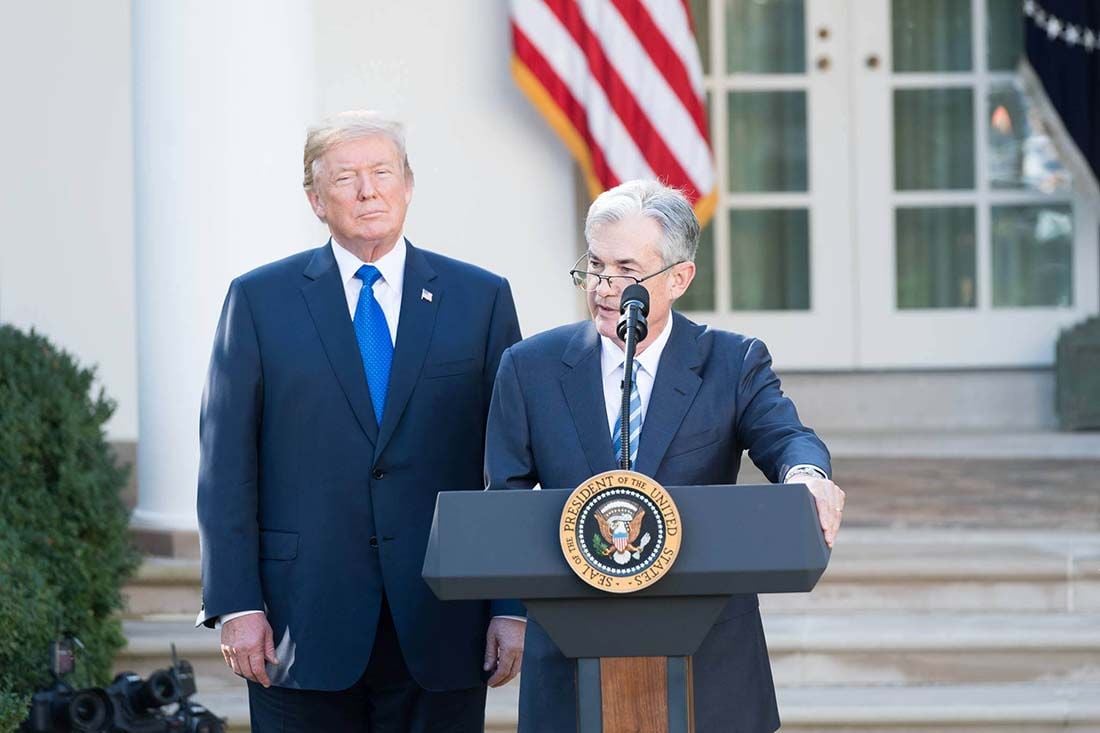
© The White House
- GBP/USD Spot rate: 1.2254, down -5.9% last week
- Indicative bank rates for transfers: 1.1941-1.2046
- Transfer specialist indicative rates: 1.2086-1.2160 >> Get your quote now
The Pound-to-Dollar rate closed its worst week since the Brexit referendum Friday after suffering a near-6% loss but it faces a pickup in volatility as national 'epidemic curves' rise and fall in the week ahead and ultimately, the risk of further steep declines as the UK epidemic gathers pace.
All markets saw extreme volatility last week with Thursday's losses putting many stock indices on course for their worst week in history before Federal Reserve (Fed) actions and a significant announcement from President Donald Trump saw them more-than reversing earlier losses. However, and throughout all of this, Pound Sterling got almost no respite whatsoever. Sterling fell steeply against seven of nine major rivals last week.
“This is negative price action. The move below the 1.2550/61.8% retracement targets the 78.6% retracement at 1.2290 – this is regarded as the last defence for the 1.1958 September low,” says Karen Jones, head of technical analysis for currencies, commodities and bonds at Commerzbank. “Rallies are likely to now find the 200 day ma at 1.2705 acts as near term resistance and we look for the market to ideally fail on rallies into the 1.2705/60 band.”
The Pound-to-Dollar rate crashed through a key level on the charts amid broad weakness in the British currency and strong demand for the greenback. Sterling fell through 1.2550, which coincides with the 61.8% retracement of the September 2019 uptrend, on Friday in what is a bearish technical development. And it closed the week having taken out the next level down at 1.2290, which risks a sheer drop toward and below the 1.20 handle this week.
Sterling is being pushed to levels only really been seen when the market's 'no deal Brexit' fears were at their most palpable. Losses of last week's size should mean Sterling is owed some respite but in light of an unprecedented situation around coronavirus, only time will tell what the week ahead will offer.
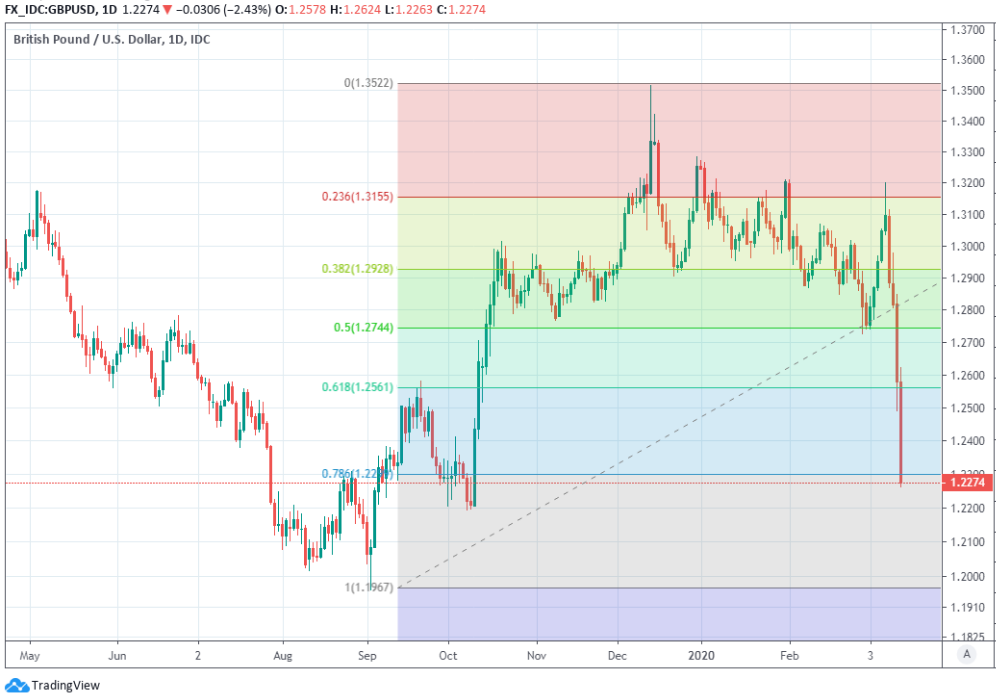
Above: Pound-to-Dollar rate at daily intervals, breaking through 61.8% & 78.6% fibonacci retracements of 2019 trend.
The Pound will start trading Sunday around 1.2254 as investors digest an eventful weekend in which both the U.S. extended its travel ban to include those coming from the UK while the Foreign and Commonwealth Office has advised against all but essential travel to the U.S.
"It probably makes sense to stay away from currencies, equities and credits in markets that are faced with an underlying exponential spreading of Corona still" says Martin Enlund, chief FX strategist at Nordea Markets. "While oversold conditions and Fed action could boost risk appetite further in the near term (USD-positive), still-lofty valuation of equity markets & the pattern during the past two US recessions leave us more than a little cautious...despite more benign demographics, the US may look like a larger Italy within a month."
Travel bans were exchanged as UK government advisers extolled the benefits of so-called 'herd immunity' while government ministers took to the tabloid papers to urge manufacturers including JCB and Rolls Royce to adapt their production lines so that they can produce ventilators for the National Health Service. Italy's experience in the north has been that 10% of coronavirus sufferers require mechanical ventilation and intensive care.
"Italy may still be 2-3 weeks away from the peak, and the rest of Europe (and the US) another week or so behind Italy. Unfortunately, as several national healthcare systems are running out of capacity, countries have begun to restrict the number of people being tested to only seriously ill cases, which distorts this comparison. In the UK, this has been disguised as a policy of “herd immunity”, although hard to believe, and the sense here in London is indeed that within days, the government may make a U-turn on this," says Eric Nielsen, group chief economist at UniCredit Bank.
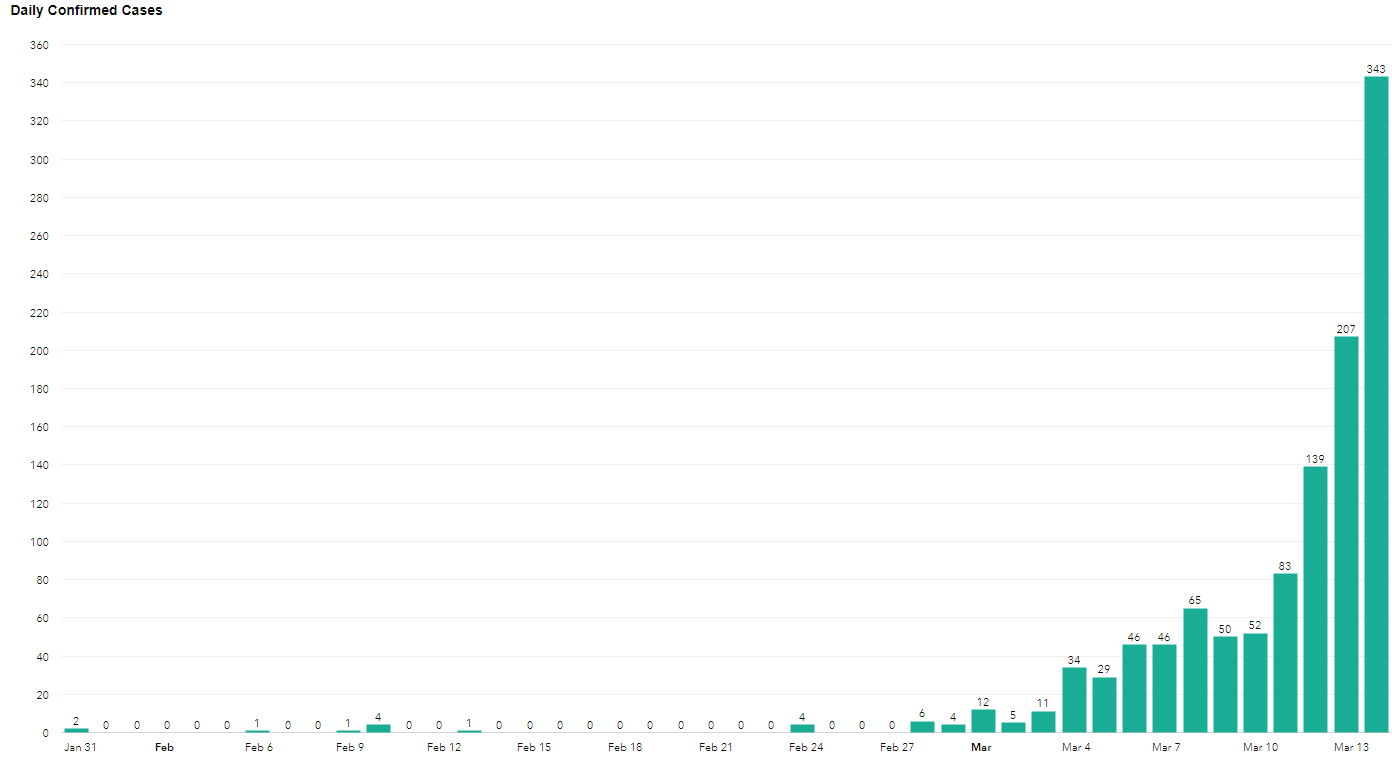
Above: Number of UK coronavirus cases confirmed on a daily basis. Source: UK Government.
Britain has been fortunate enough so far to enjoy one of the lowest per-capita coronavirus infection rates, perhaps because of its segregation from mainland Europe via the English Channel, but infection numbers have risen rapidly in recent days and government as well as broader society are increasingly bracing for a further surge in infections as the outbreak well and truly gets underway. There were 1,372 UK infections as of 0900 Sunday, with 35 dead. Both numbers are up sharply from 387 infections and 6 deaths known of on Wednesday 11, March. This could have significant downside implications for the Pound.
Investors often say the aim of the game in financial markets is to 'buy low and sell high' but the rub for Sterling is that applying such a strategy to the currency market would likely require the British currency and the Euro to be sold while others like the Chinese Yuan and Korean Won are bought. Epidemic curves are well and truly in decline in China and Korea while outbreaks in the UK and other parts of Europe are only just getting underway.
Such an approach is complicated by the fact the U.S. is also experiencing a sharp increase in coronavirus cases, much like the UK, after initially holding off the virus. However the U.S. Dollar is the world's reserve currency and its largest, most liquid unit which means it's often the go-to destination in times of risk-aversion. That safe-haven status hasn't always been evident in recent weeks but at a time when financial markets are seeing extreme volatility, some say it would be foolish to bet against the Dollar.
“We expect further action next week from the Fed and while it would be foolish to bet against the dollar in current market conditions, policy steps being taken suggest building downside risks for the dollar once COVID-19 data provides evidence that the crisis is nearer the end than the beginning,” says Derek Halpenny, head of research, global markets EMEA and international securities at MUFG. ““There are only two factors now that will shape investor sentiment and financial market conditions – COVID-19 data and global policymakers’ response to the crisis. The news on the former is still not particularly good, but action from the Fed yesterday offers hope on the latter.”
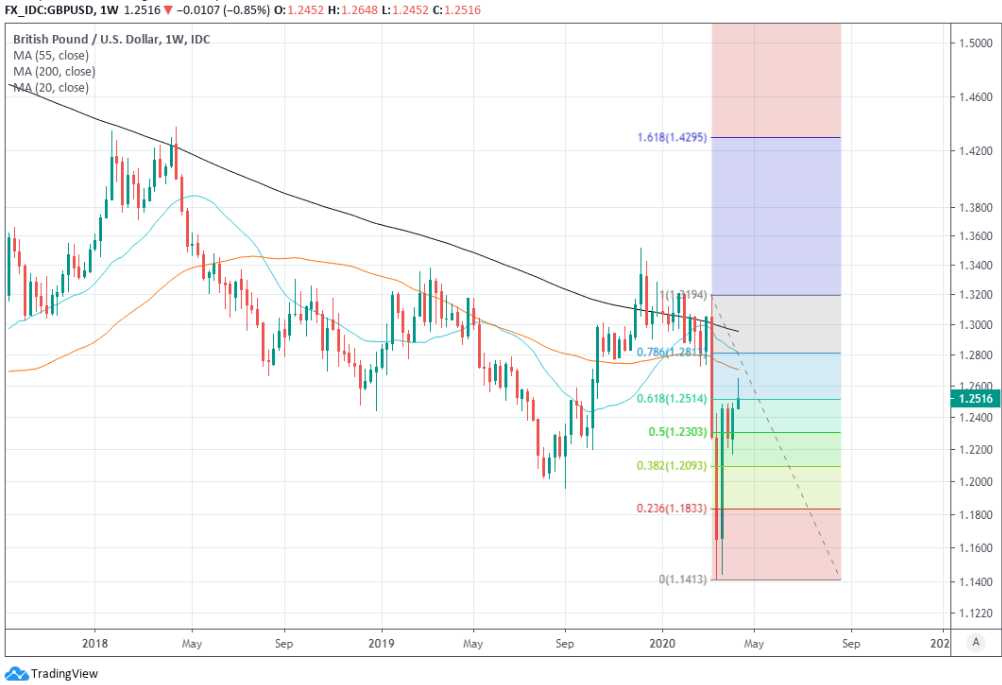
Above: Pound-to-Dollar rate shown at wekly intervals.
The Pound and Dollar: What to Watch in the Week Ahead
There is a range of economic figures due from the UK and U.S. in the week ahead, which would normally be important drivers of exchange rates but these all matter very, very little in the current market where the infection growth rates, death rates and the actions of authorities will are the only things that matter.
Economic data will become relevant again in the months ahead but this week's figures relate primarily to the economy of January and February, which is moot at a time when authorities are facing a de facto choice between allowing their economies or their health systems to collapse. Steepening epidemic curves (increasing infection growth rates) risk overloading healthcare systems given that 10% of patients suffering from the virus require intensive hospital care.
“We have seen a very high number of ICU admissions, almost entirely due to severe hypoxic respiratory failure requiring mechanical ventilation. The surge can be important during an outbreak and cluster containment has to be in place to slow down virus transmission. We are seeing a high percentage of positive cases being admitted to our Intensive Care Units, in the range of 10% of all positive patients,” says Prof. Jozef Kesecioglu, president of the European Society for Intensive Care Medicine, in an email to colleagues dated March 04. “We wish to convey a strong message: Get ready!”
For now the market focus is on trends in epidemic curves and actions to stem the spread as well as provide support for economies.
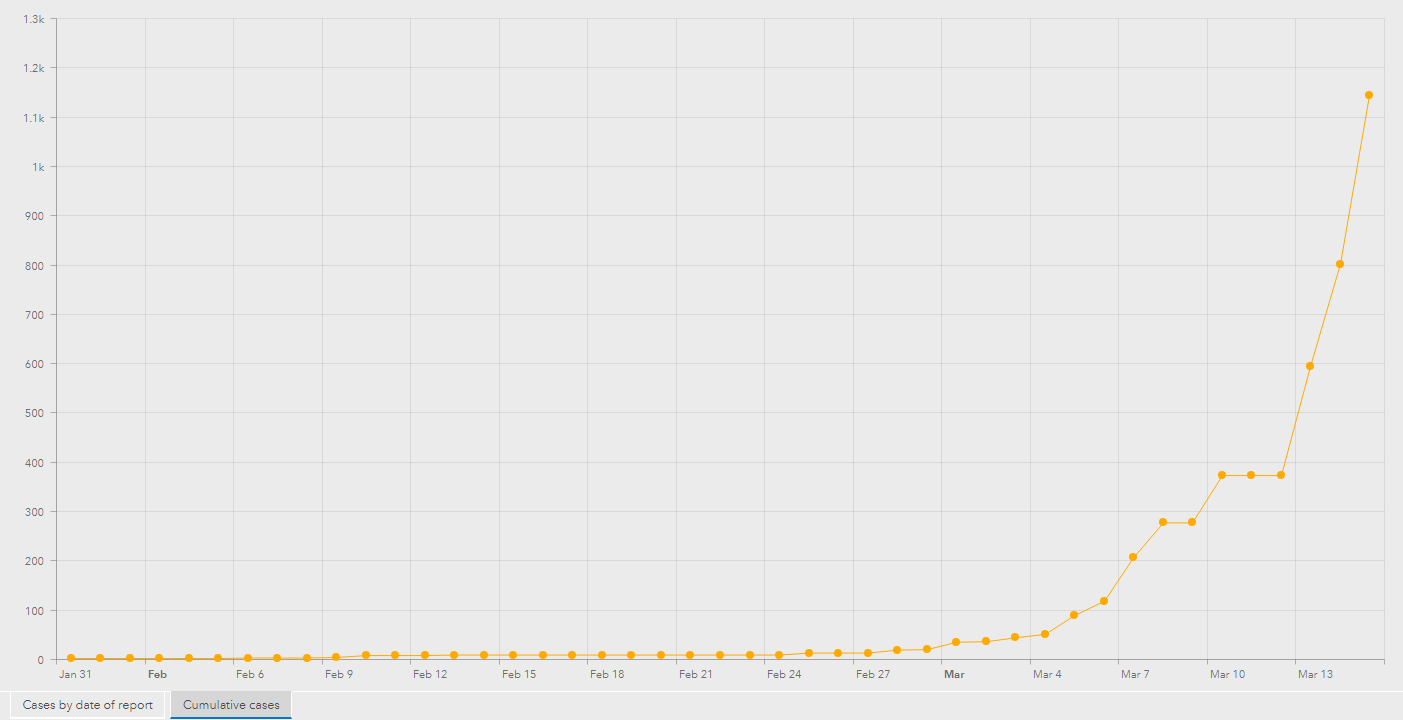
Above: UK epidemic curve. Source: World Health Organization.
France and Spain joined Italy in locking down citizens - which forbids all but essential travel from the home - at the weekend, risking unprecedented damage to their economies and likely necessitating a combined government and central bank response like no other seen in modern history.
Meanwhile New Zealand and Australia, which have among the lowest number of cases among major economies, announced at the weekend that travellers visiting the countries will need to self-isolate for 14 days. Tourist volumes, an important source of economic growth, had already collapsed everywhere in recent weeks although these moves could ensure the antipodean countries remain effectively closed to many holiday makers for the foreseeable future.
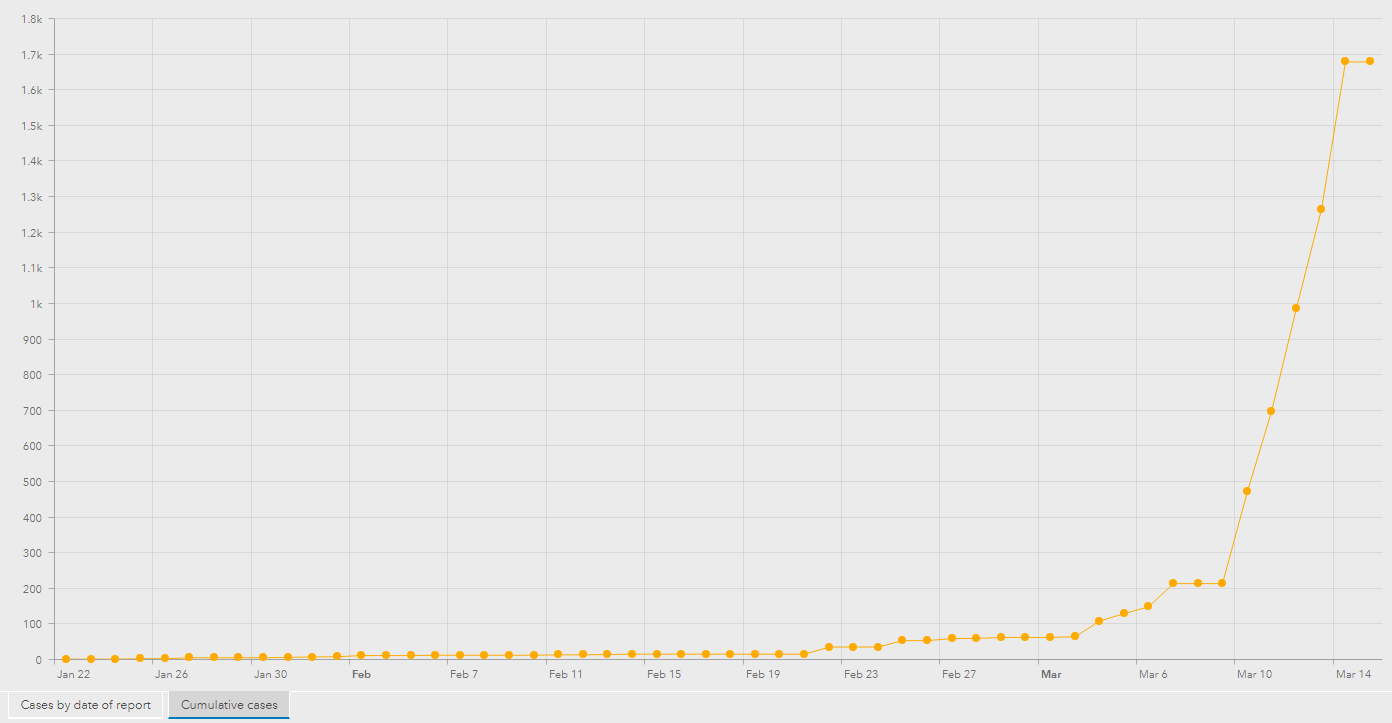
Above: U.S. epidemic curve. Source: World Health Organization.
This is the backdrop against which Monday's G7 meetings of central bank heads and finance ministers will take place and outcome of them will be key for investor sentiment and the mood in markets this week, although Wednesday's 18:00 Federal Reserve policy decision will also be important.
There's a risk that something is announced by the Fed before Wednesday's scheduled decision to maximise the impact of any measures. The Fed has already all-but launched a fourth round of quantitative easing.
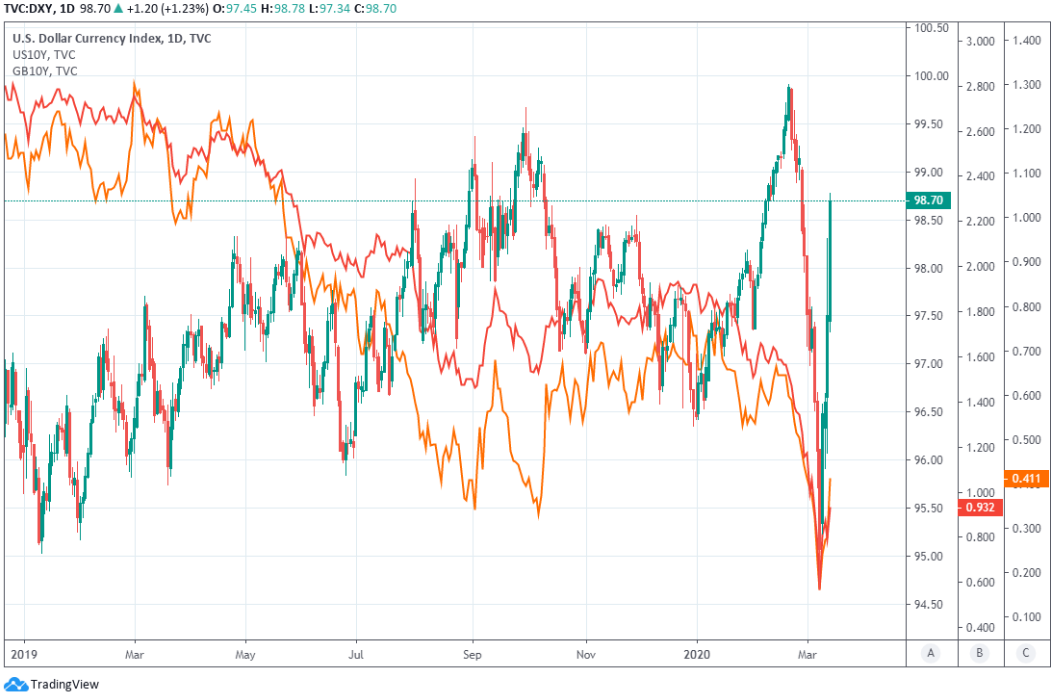
Above: Dollar Index shown at daily intervals alongside GB and U.S. 10-year Gov yields, which rise as bonds are sold.
The Bank of Canada (BoC) announced its second surprise interest rate cut after the European close last Friday and just before President Donald Trump declared a state of emergency, "unleashing the full force of the federal government" and unlocking around $50 bn in disaster relief funds. Congress has since reached a bipartisan agreement on measures to provide further support to U.S. companies and households as they grapple with the virus.
"The reported number of U.S. cases continues to rise sharply, and further dramatic-looking increases are inevitable as testing is ramped up, and the virus continues to spread Given that testing is not universal and most people with the virus don't need medical attention, the only way we'll know for sure that the outbreak is over is when the number of deaths begins clearly to fall. The number of deaths is still rising rapidly," says Ian Shepherdson, chief economist at Pantheon Macroeconomics.
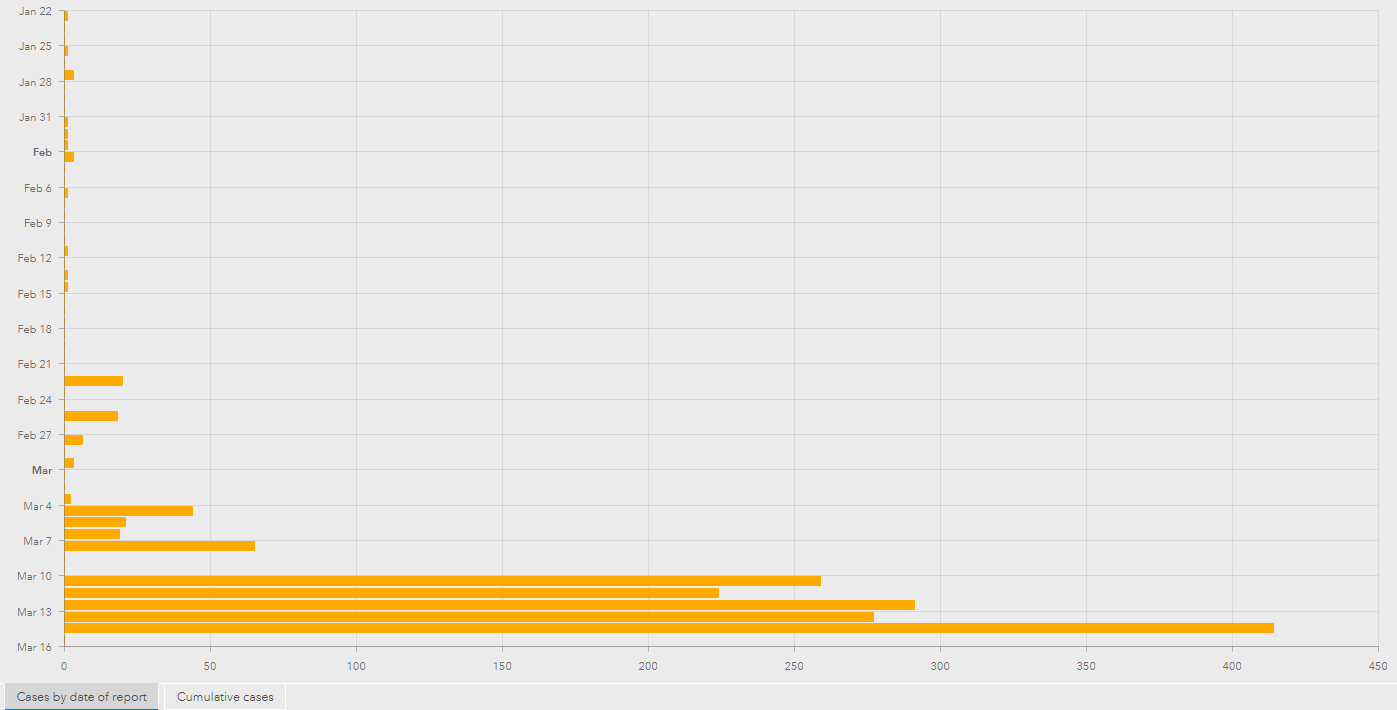
Above: U.S. daily disclosures of new infections. Source: World Health Organization.
The Pound is at particular risk from a steepening epidemic curve for reasons including its earlier fortune in dodging a severe outbreak, which is now unwinding and could see Sterling becoming the "pariah" of the market. The Dollar, on the other hand, is the world's reserve currency and its largest, most liquid unit. That often makes it the go-to destination in times of risk-aversion.
Pound Sterling underwrites activity in the City of London, where assets under management are more than three times national GDP in the good times, and so could be vulnerable to capital flight in the event the UK suffers a sudden surge in coronavirus infections and deaths that threatens the smooth operation of London. It's also at heightened risk because of the government's strategy. The UK also has a large current account deficit, which means Sterling relies for part of its value on continuous inflows of foreign capital that risk being interrupted.
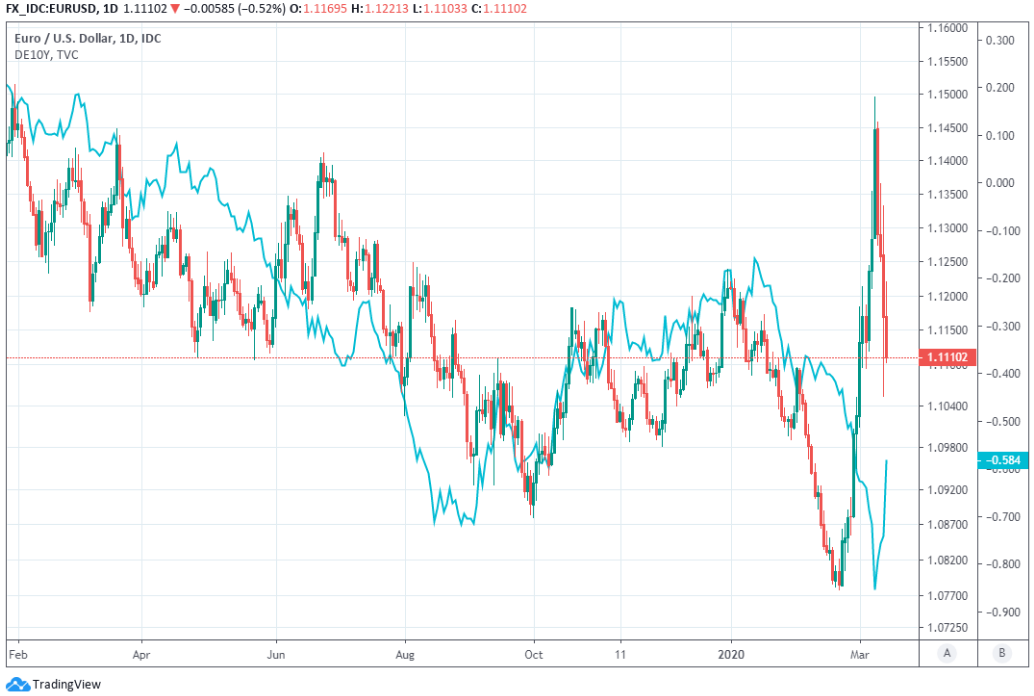
Above: Euro-to-Dollar rate at daily intervals. Correlation with 10-yr German bond yield goes into reverse from February.
"As countries with large outbreaks of Covid-19 move to testing only people sick enough to be in hospital, their data—and hence aggregate regional and global data—cease to be reliable. We don't know how many people have the disease, and we don't know how rapidly it's spreading," Shepherdson says. "It does seem, though, from data earlier in the outbreak, that cases in large outbreaks double every three our four days. That means, in theory, that an outbreak of 1,000 cases becomes more than a million cases after just 33-to-44 days."
The UK government moved from the "contain" phase of its strategy to the "delay" phase last week but there's very little difference in the actions and advice of government under the two purportedly different phases. Furthermore, and although a minister has denied the government's strategy is to pursue so-called 'herd immunity', its advisers have increasingly made use of the term.
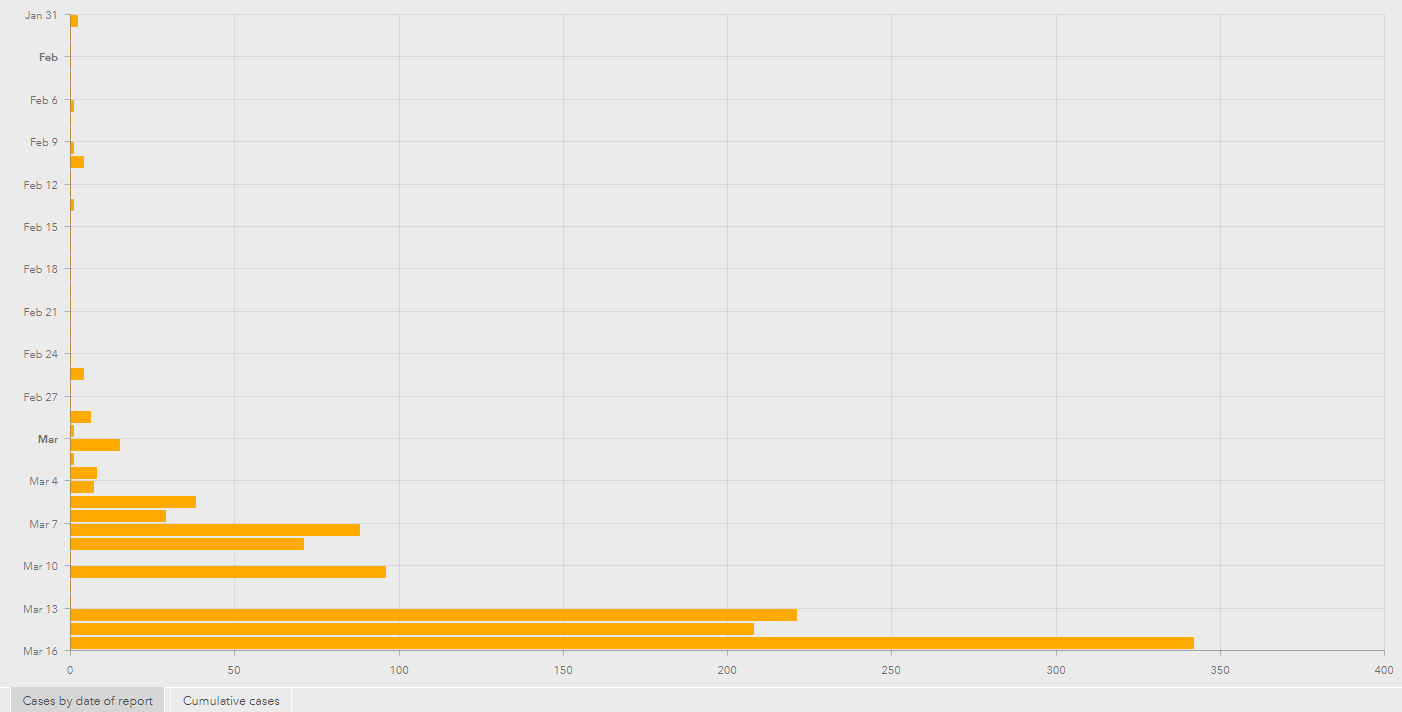
Above: UK daily disclosures of new infections. Source: World Health Organization.
'Herd immunity' could arguably be described as a 'don't bother' strategy in which the coronavirus infection is left to work its way through society, claiming whoever it does in the absence of actions to protect the nations oldest and most vulnerable citizens. The Scientific Advisory Group for Emergencies (SAGE) said Saturday "the next planned effective interventions (shielding the vulnerable and household isolation) will need to be instituted soon."
"We have a plan, based on the expertise of world-leading scientists. Herd immunity is not a part of it. That is a scientific concept, not a goal or a strategy. Our goal is to protect life from this virus, our strategy is to protect the most vulnerable and protect the NHS through contain, delay, research and mitigate." says Health Secretary Matt Hancock in a Sunday article for The Telegraph, which is available without paywall on the gov.uk website.




